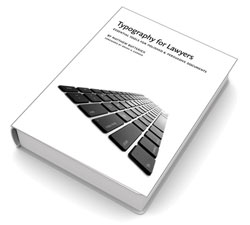Artist-Turned-Lawyer Highlights Typographic Detail in Legal Docs

Anyone who has seen a recent Utah Supreme Court opinion may have noticed that something is different.
The court’s opinions look more readable and just may be more convincing thanks to the typographic wisdom of graphic artist-turned-lawyer Matthew Butterick.
Click to see how the Utah Supreme Court opinions looked before (PDF) compared to now (PDF).
Butterick provides tips to lawyers (and apparently judges) on how to make their legal documents more effective through typography. His advice has been compiled into a recently published book called Typography for Lawyers.
The book started out as a blog of the same name that Butterick started writing in 2008 after noticing a surfeit of poorly formatted documents arriving in his office.
The book, like the blog, discusses how typographic details such as spacing, punctuation, symbols, fonts, numbering and margins affect the visual aspects of legal documents. Butterick also makes the case for why typography matters in legal documents: Good typography helps make documents more engaging, which in turn makes them more persuasive.
“There’s not some sort of rule that legal documents have to be ugly and terrible,” Butterick says.
The U.S. Supreme Court offers an example of some of the best typography in the nation, he says. “They issue opinions that adhere to the principles of good typography: appropriate font size, use of Century Schoolbook (instead of Times New Roman or Arial), wide margins, line spacing that’s not too tight or too loose, no underlining.” He does knock the high court’s practice of putting two spaces after punctuation. “But I’ll let it go,” he says.
So how can lawyers improve their documents? Put one space between sentences, not two. The second one creates too much white space on a document. Don’t use a 12-point font. It’s too big. Ten- (as seen here) or 11-point fonts are easier on the eyes. And, if you follow these and other tips, you can stretch your page limits.
“I understand that some of my advice can be used for good and some can be used for evil,” says Butterick. “You know, it’s a profession of advocacy, right?”



